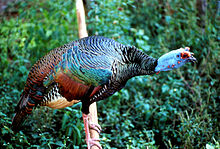
Back Kalkoen Afrikaans دجاج رومي Arabic دجاج رومى ARZ Meleagris AST Hind quşu Azerbaijani هیندوشکا AZB Күркә Bashkir Kalkun BAN Pabo (hayop) BCL Пуйки Bulgarian
| Turkey Temporal range: Early Miocene – Recent
| |
|---|---|

| |
| A male wild turkey strutting | |
| Scientific classification | |
| Domain: | Eukaryota |
| Kingdom: | Animalia |
| Phylum: | Chordata |
| Class: | Aves |
| Order: | Galliformes |
| Family: | Phasianidae |
| Subfamily: | Phasianinae |
| Tribe: | Tetraonini |
| Genus: | Meleagris Linnaeus, 1758 |
| Type species | |
| Meleagris gallopavo (wild turkey) Linnaeus, 1758
| |
| Species | |

The turkey is a large bird in the genus Meleagris, native to North America. There are two extant turkey species: the wild turkey (Meleagris gallopavo) of eastern and central North America and the ocellated turkey (Meleagris ocellata) of the Yucatán Peninsula in Mexico. Males of both turkey species have a distinctive fleshy wattle, called a snood, that hangs from the top of the beak. They are among the largest birds in their ranges. As with many large ground-feeding birds (order Galliformes), the male is bigger and much more colorful than the female.
The earliest turkeys evolved in North America over 20 million years ago. They share a recent common ancestor with grouse, pheasants, and other fowl. The wild turkey species is the ancestor of the domestic turkey, which was domesticated approximately 2,000 years ago by indigenous peoples. It was this domesticated turkey that later reached Eurasia, during the Columbian exchange.
